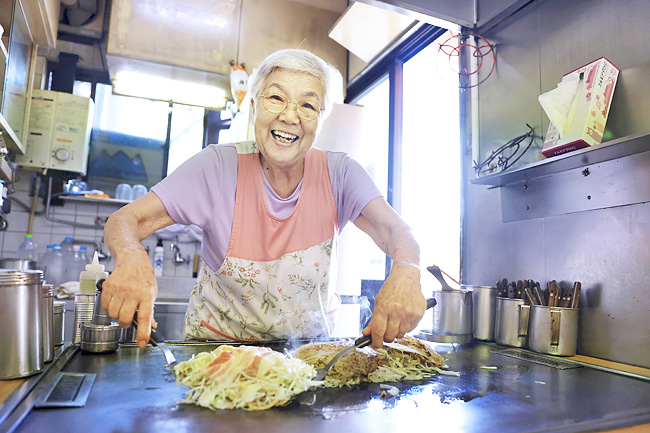ANN/THE YOMIURI SHIMBUN – The preparation of an okonomiyaki savoury pancake on a hot griddle or teppan, can make anyone’s mouth water.
Japan has many okonomiyaki restaurants, but the generosity of the woman who manages Okonomiyaki Kajisan makes the eatery quite unique. The reason behind it also is what makes the place special.
Toshiko Kajiyama’s small okonomiyaki restaurant in Minami Ward, Hiroshima, can only seat eight. The room is always hot, but the air is filled with the delicious smell of okonomiyaki sauce. The space is small, but comfortable.
The restaurant is near the foot of Hijiyama hill, about 10 minutes by car from JR Hiroshima Station. When I walked through the red noren curtain at the entrance, I was greeted by Kajiyama, 82, holding metal spatulas used for cooking okonomiyaki.
While I was there, I would occasionally see her husband, Noboru, 83, coming and going from the kitchen. Kajiyama said he goes out shopping for okonomiyaki ingredients.
“I think he wants to be of help, but he gets in the way,” Kajiyama said.

“Okonomiyaki: 500 yen” is written above an old menu board in the restaurant. An Okonomiyaki Kajisan okonomiyaki consists of meat, shredded cabbage, Chinese noodles covered with okonomiyaki sauce, cooked batter and a fried egg, which are all placed on top of each other.
The thick, sweet sauce goes well with all the ingredients, and the flavours are enhanced when eaten on the hot teppan. This type of okonomiyaki would normally cost around JPY1,000 at some famous restaurants in the city. “I haven’t raised prices for more than 30 years,” Kajiyama said. Asked why, she spoke about her experiences from 78 years ago. On August 6, 1945, the atomic bomb was dropped near her home, which was 1.2 kilometres from the hypocenter.
She was four years old. She has few memories of that time.
While radioactive black rain was falling, she fled with her grandparents to a temple designated as an evacuation centre. After the bomb was dropped, her mother headed closer to the hypocentre to help break down buildings to prevent fires from spreading. She never returned.
“I don’t know where she died,” Kajiyama said. “We never found her remains.” Her father had died of an illness soon after she was born, and now she had lost her mother. The atomic bombing had left her orphaned. After World War II, she was raised by her grandparents in barracks. When she was a sixth-year elementary school student, she joined Hiroshima Kodomo o Mamoru Kai, an organisation established to support children who became orphans after the atomic bombing until adulthood.
There, she learned dressmaking, cooking and other skills. Noboru was also a part of the organisation. She married Noboru when she was 20 and gave birth to their first son at 23.
Six months later, in February 1965, they renovated their house to open an okonomiyaki restaurant.
At first, she planned to open a small business she could run at home while her husband was away. But once she opened the restaurant, it became her reason for living. “I have been supported by many people after becoming orphaned by the atomic bombing,” Kajiyama said.
“I can repay their kindness if I can make others happy with my okonomiyaki at this price.” – Taiga Oka






